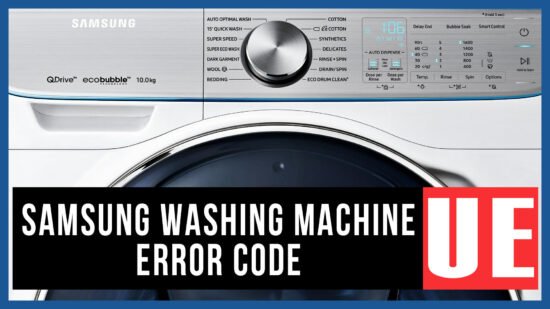
You might be wondering why a washing machine, a hefty appliance designed to handle your dirty clothes, would be thrown off by an imbalance. Well, think of your washing machine as a really strong but sensitive dancer. It needs everything to be just right to perform its best. An unbalanced load can make your washing machine wobble like a ballerina on ice, potentially leading to wear and tear if not corrected. Let’s dive a little deeper into common causes for this error message and how you can fix them easily, like a pro troubleshooting your own appliance.
Understanding Load Imbalance
The “UE” error code on Samsung washing machines primarily relates to load imbalance. Imagine moving furniture: if everything is evenly balanced, it glides across the floor easily. But if there’s too much weight on one side, it becomes a struggle. Similarly, your washing machine spins thousands of times per minute. If the load inside isn’t distributed properly, it could cause the drum to shake violently. This imbalance is a common cause of the “UE” error code.
Washing machines are designed to detect this kind of imbalance as a protective measure. If the drum is shaking too much, it could damage the internal components or even cause the machine to “walk” across the room! To avoid this, the machine stops and flashes the “UE” code, like a time-out to let you know it needs some assistance in balancing the load. Understanding this can help you become a laundry day hero, ensuring a smooth and efficient cycle every time.
To fix a load imbalance, try redistributing the clothes inside the drum. If you’ve got heavy items, they might be sticking together, acting like a tug-of-war against the smooth operation. Open the door, move things around, and try to balance light and heavy clothes evenly. If you’re washing a single bulky item, you might want to add a couple of towels to even it out. It’s like giving your washer a helping hand to carry the load.
Incorrect Washer Placement
Another sneaky culprit behind the “UE” error could be the placement of your washing machine itself. Just like how you need a level playing field for a fair game, your washing machine needs a flat, even surface to operate correctly. If it’s positioned on a slant or uneven flooring, it can throw off the balance of the machine, causing the drum to spin unevenly and triggering the error code.
To check if your washing machine is placed correctly, you can use a simple carpenter’s level. Place it on top of the machine. If the bubble is centered, your machine is on solid, level ground. If not, you might need to adjust the legs of the machine. Most modern washing machines come with adjustable feet. By turning these feet, you can raise or lower each corner until the machine is perfectly level. It’s like adjusting the legs of a wobbly table until it sits steady.
Once your washing machine is level, you’ll likely notice an immediate improvement in its performance. This simple adjustment can prevent future “UE” errors and help your machine run smoothly for years to come. It’s a small step that delivers big benefits, keeping both your appliance and your sanity intact.
Issues with Load Type
Not all laundry loads are created equal. The type of items you wash together can greatly impact whether or not you see that dreaded “UE” error code. Washing machines, like us, prefer variety. Imagine trying to run with just one shoe; that’s how your washer feels when it’s loaded with one heavy item, like a large blanket, without anything to balance it out.
When washing heavy items like towels, blankets, or jeans, it’s important to balance them with lighter items. This prevents them from clumping together on one side of the drum. If you’re washing a couple of heavy items, try adding a few lighter pieces to even things out, much like adding extra players to a team to make it stronger and more balanced.
Another tip is to avoid overloading the washer. It might be tempting to throw everything in at once, especially when you’re behind on laundry, but overloading can lead to more than just a “UE” error; it can also strain the motor and reduce the lifespan of your machine. Think of your washer’s drum like a dance floor. It needs space to spin freely without any overcrowding. So, give it some room, and it will reward you with fewer error codes and cleaner clothes.
Next Steps and Prevention Tips
Now that you’ve tackled the immediate issue of the “UE” error, you might be thinking about ways to prevent it from happening again. An ounce of prevention is worth a pound of cure, especially when it comes to household appliances. The key here is regular maintenance and being mindful of how you load your washer.
Make it a habit to periodically check the balance and level of your washing machine. Just as you’d tune up a car to keep it running smoothly, giving a little attention to your washer can go a long way. Ensure that your machine is on a sturdy, level surface, and periodically check the adjustable feet to make sure they haven’t shifted over time.
Additionally, practice good loading habits. Mixing up clothes of various sizes and weights can help to keep the load balanced naturally. If you regularly wash large, bulky items, consider breaking them into smaller loads or adding lighter items to keep things even. These simple steps can prevent most issues before they start.
In conclusion, understanding the causes of the “UE” error code can turn a frustrating situation into a manageable challenge. By balancing the loads, ensuring level placement, and attentively loading, you’re not just solving a problem—you’re taking proactive steps to extend the life of your washing machine. With a little effort, you can save time, stress, and maybe even a service call, keeping your laundry days trouble-free.